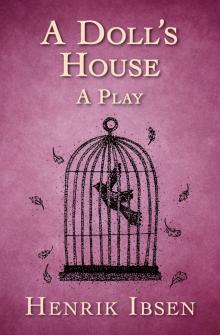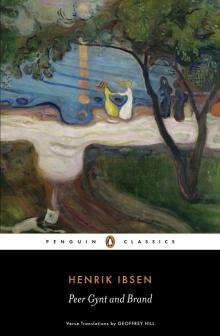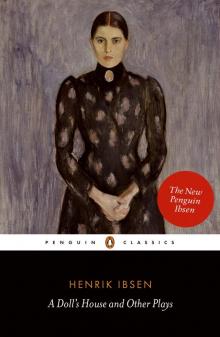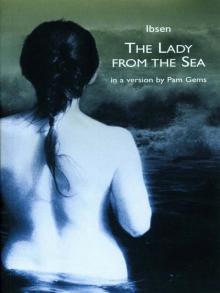- Home
- Henrik Ibsen
Peer Gynt and Brand Page 2
Peer Gynt and Brand Read online
Page 2
Religion is central to the play, with its many discussions of what it means to be a Christian. The Dano-Norwegian church was riven by dissent in the mid nineteenth century, with opposing factions asserting different interpretations of God’s word. On the one hand was a more optimistic, sunnier kind of belief, stressing the positive sides of living a good life, having faith in God and judging mildly, often referred to as Grundtvigianism after the Danish theologian N. F. S. Grundtvig. This is the school of thought represented by Einar early in the play, by Agnes throughout and to some extent by the Dean. On the other hand were the pietistic movements which sprang up around the country from early in the century, demanding remorse and repentance in an unending battle against man’s sinful nature, seen here in Einar’s later incarnation and in some of Brand’s more extreme pronouncements. One such pietist, Gustav Adolph Lammers, was the vicar of Ibsen’s home town of Skien, and Ibsen acknowledged him as a source of inspiration for the play. And then, of course, there was the prominent Danish philosopher Søren Kierkegaard. Ibsen maintained that he had read little of Kierkegaard and understood even less, but his ideas were current in intellectual debate in the mid nineteenth century. Brand explores the conflict between what Kierkegaard refers to as the aesthetic and the ethical modes of living, as represented by the opposing philosophies of Einar, the man whose life is dedicated to the pleasures of sensory experience, and Brand, with his focus on living in a principled way, not for his own profit but for the good of society. The play also mirrors Kierkegaard’s criticism of the established church and his insistence on the necessity of absolute commitment to an ideal. 10
Brand strongly reflects the events of Ibsen’s own life – not only his political indignation but his personal odyssey. He may have been writing in the light of the Italian south, but his thoughts were still in Norway, drawn back mentally as Brand is physically to the ice and snow, the deep sunless valleys and what he represented as the petty provincial obstructionism. Norway rarely gets a good press in Ibsen’s writings after 1864; he rejected it as he felt it had rejected him. The obsession with heredity, with the inheritance of sin, which weighs so heavily on Brand – the burden of his mother’s greed, his parents’ hateful marriage and the unintended consequence of the birth of the deranged Gerd – runs like a red thread through many of his later plays, such as Ghosts and Rosmersholm. Money, the acquiring of it and the losing of it, was an insistent personal issue and is the catalyst for intergenerational conflict here as it is, for example, in The Wild Duck and John Gabriel Borkman.
In the end, however, it is not the topicality of the play or its reflection of its author’s mental state which makes it appeal to audiences and directors today; it is the fascination of the central character’s battle with his surroundings and his own demons. What starts out as a crusade against the folly of others – the fecklessness of Einar and Agnes, the dullness of the peasant community, the madness of Gerd – slowly becomes a shutting out, literally, of any light in the darkness of despair. The demands of absolute commitment to his ideal drive Brand into a corner where he must collude in the destruction of all that is dear to him; whenever he wavers, some portent or warning materializes to cut off his retreat. Even the doctor, the voice of reason here as in so many of Ibsen’s plays, goads him into inflexibility by commenting that Brand’s harsh repudiation of his mother’s pleas melts into compromise when his son is ill (‘One law for the world, / another for your child’). Brand denies himself and those around him any chance to say ‘I have done enough’ and climbs further and further into an icy barren region where his only companion at the last is his soul-sister Gerd, his own reflection in a broken mirror. His dream of a new society has grown into a nightmare which cuts him off from all society; in his striving to create a utopia he has become a dictator. As Helge Rønning says in his study of the play, at the end he has become his own victim, and Brand is thus a tragedy – the only one, he maintains, that Ibsen wrote.11
It is perhaps more difficult in these secular times for an audience to sympathize with a character who feels called upon by God to deny his own humanity. Yet the play is nevertheless compelling in its study of devotion to a calling taken to its ultimate conclusion, a conclusion as devastating for the individual as for his surroundings. ‘Brand is myself in my best moments,’ Ibsen declared a few years later.12 Like many other of Ibsen’s pronouncements, this one might well be treated with a little scepticism, but it is a corrective to a complete condemnation of the character. So too is the ending of the play. Brand’s ultimate anguished questions – have I done enough to be saved? Does all my striving count for nothing? – are answered by the cryptic pronouncement ‘He is the God of Love’ (‘Han er deus caritatis!’ in the original). This might be understood as a rebuke to Brand – you have misunderstood all your life, the harsh God you have served is your own creation – or as a statement of reconciliation: he is a loving and accepting God, you too will be forgiven and welcomed. Or perhaps, probably, both.
The verse in which the play is composed is as accomplished as it is difficult to reproduce in translation.13 Nearly all of it is written in four-foot lines which sweep the action along, sometimes in iambic and sometimes in trochaic metre, with frequent but not always regular rhymes. It is a flexible verse form which can convey both the rapid interchange of colloquial dialogue and the more reflective musings of Brand’s monologues. The action often proceeds by a series of repetitions, parallels and oxymorons which bring the opposing values in the play into stark contrast and are also a feature of Geoffrey Hill’s poetic rewording (‘A middling this, a middling that, / never humble, never great. / Above the worst, beneath the best, / each virtue vicious to the rest.’) The exception to this verse form is Einar and Agnes’ bridal song in Act One, where the steady rhythm of Brand’s observations is broken by a leap into a traditional ballad form, a springing, dancing celebration – and the only section of the ‘Epic Brand’ to survive practically unchanged into the final drama. Hill’s version of Brand does not attempt a direct translation of the original, but it does follow closely the shifts in mood and tempo of the different scenes and captures the muscular beat of the central character’s relentless compulsion.
Peer Gynt
Peer Gynt stands for everything Brand despises. Or rather, one might say, he doesn’t stand for anything. He runs, he hides, he evades pursuit and definition. If Brand is placed at one extreme in his refusal to compromise, Peer must be seen at the other; rather than confront any challenge or face down any obstacle, he goes round and about, takes a detour, as he does with the Boyg. He refuses to make a choice and stick to it; whenever any commitment is demanded, he backs off. Playing with the trolls, even marrying one and adopting their lifestyle, is fine; but when asked to agree to an action which would cut him off irrevocably from the human world, he baulks at it. He needs to be assured, as he tells his business associates in Act Four, that ‘one who’s crossed a bridge can take / at any time the same bridge back’. That is why he realizes in the Cairo madhouse: ‘I am a sheet of paper on which nothing is written’; and why, when he peels the onion of the Gyntian self, he finds no core. He spends his life asserting himself bombastically but does not know who he is. And that is also why, as the Button Moulder explains, he must be melted down; he is a failed project whose components can be reused for something better.
Yet although the conclusion may be a depressing one, both the protagonist and the author have a lot of fun on the way. Peer is a liar, that is established in the first line of the play; but by the same token he is also a poet (a duality which is evident in several of Ibsen’s later flawed heroes). Peer’s refusal to face unpleasant facts diverts him into realms of fantasy in which he creates and peoples whole worlds; he leads his listeners off on riotous adventures and sees in nearly every situation a chance to invent new kingdoms and new dreams. Indeed, the play as a whole, or the latter part of it, might be seen as a dream, as Peer’s dream about himself, in which the other characters represent aspects of himself or
embody alternative directions he might follow.14
The whole play is also a poem, and Ibsen’s most impressive poetic achievement. Unlike Brand it uses a wide variety of different verse forms: iambic and trochaic tetrameters, iambic pentameters, three-beat ballad verse and four-beat knittel verse, and short two-beat lines. It often gallops along at a furious pace, as if trying to keep up with Peer’s imagination. ‘It is wild and formless,’ Ibsen later declared in a letter to the English critic Edmund Gosse, ‘recklessly written in a way that I could only dare to write while far from home.’15 A new mood or a new speaker is generally the cue for a change in rhythm and pace. Knittel was a popular medieval verse form, close to Norwegian everyday speech, with four-beat lines and a varying number of unstressed syllables, often used as the devil’s verse form (e.g. by Goethe in Faust). It is the most frequently used form in the play, spoken for much of the time by Peer as well as by characters like the Dovre King, the trolls and the Thin Man; with its abundance of syllables it is jaunty and witty. The ballad verse, on the other hand, is a lyrical, more reflective form, used for example by the dying Aase waiting for Peer to return home. Only one scene in the play is written in iambic pentameters, and that is the priest’s funeral oration in Act Five about the man who chopped off his finger as a boy to avoid conscription. It underlines the solemnity of the occasion and the importance of the speech about someone who remained true to himself. (This story originated in the ‘Epic Brand’; the fact that Ibsen saved it from there and transferred it, much expanded, to this later play, indicates its significance to him.)
As he did with Brand, Ibsen drew on a variety of sources for this play. There was a renewed interest in folk belief and the oral tradition in mid-nineteenth-century Norway as part of the National Romantic movement, and folk tales and legends were collected and published by scholars such as P. Chr. Asbjørnsen and Jørgen Moe. One of Asbjørnsen’s tales tells of Per Gynt from Gudbrandsdal, a hunter who shot bears and encountered the Boyg of Etnedal, and the story of the ride on the buck’s back is taken from another of his tales about a local character, Gudbrand Glesne.16 Ibsen himself had been on a walking tour of Gudbrandsdal in 1862 to collect folk legends and sayings. Stories of trolls are legion in Norwegian folklore; they are threatening but usually not very bright, and easy to outwit. The perky young adventurer from folk tales Askeladden (the Ash Lad), who starts with nothing and ends up marrying the princess and inheriting half the kingdom, is another obvious model for Peer. Topical references abound; Norwegian self-satisfaction is pilloried, though with more good humour than in the previous play – and the idiosyncrasies of other nationalities are also satirized. National Romanticism itself is not spared, as when the much reduced Dovre King reappears at the end to complain that he is told he only exists in books, and the best way he can survive is to audition for a role in a national drama.
Other literary antecedents can also be traced in the play. It can be seen as a kind of morality play, a story of Everyman in a search for salvation, and has elements of the picaresque and the travel narrative, borrowing especially from Ludvig Holberg’s Niels Klim’s Subterranean Journey (1741), a satirical utopia peopled by fantastic monsters in the vein of Gulliver’s Travels. There are many – frequently misquoted – biblical allusions, and clear parallels with and references to Goethe’s Faust, as well as to the writings of Ibsen’s friend Paul Botten-Hansen, whose play The Hulder Wedding contains a madhouse scene, a troll-king under the mountain and a fast-talking devil similar to the Thin Man. And there are clear autobiographical elements in the story of the rich but improvident father who reduces his family to penury, and the wandering son who continually questions his own motives and his own vocation.
As with Brand, the ending of this play raises more questions than it answers. Twice the Button Moulder returns to judge Peer’s objections to obliteration inadequate; he has failed to be good enough or evil enough to have realized his potential as an individual, he has just been mediocre. The play ends before the Button Moulder returns for the third time. Will Solveig’s intercession be Peer’s salvation? It seems unlikely, as his aversion to commitment has been as stark in this relationship as in any. In her final song he returns full-circle to the beginning of his life, to be the child at his mother’s knee. His journey of education has taken him nowhere and taught him nothing. Or is Solveig just Peer’s wish-image of a woman? Is he dreaming still?
On Stage and Page
Peer Gynt was the first of these two dramatic poems to be transferred to the stage. In January 1874 Ibsen wrote to the Norwegian composer Edvard Grieg and asked him to consider composing a musical score for the play; he also suggested the kind of music which might accompany various scenes and proposed sweeping changes to the text, which involved among other things leaving out almost the whole of Act Four. Grieg accepted the commission, although it was to take him far longer and be much more demanding than he had anticipated. (‘I’ve written something for the Dovre King’s Hall,’ he complained to a friend, ‘which I literally cannot bear to listen to, it simply resounds with cowpats, Norwegianness and tothyselfsufficientness!’)17 Finally, in September 1875 he had finished the score, and the world première opened on 24 February 1876 at the Christiania Theatre, directed by the Swede Ludvig Josephson. Expectations had been high, and the reception was enthusiastic, despite the length of the performance (five hours for the première). The play was performed twenty-five times in the first season, an unusually high number and a lucrative business for the author.
The first translation of the play was into German, by Ludwig Passarge, who published it in 1881 despite Ibsen’s warning about the folly of choosing this particular play: ‘I have grave doubts in this respect. Of all my books I regard Peer Gynt as the one least constituted to be understood outside the Scandinavian countries.’18 The first translation into English was by Charles and William Archer in 1892, but the play had to wait until 1922 for its first substantial London production at the Old Vic.
Once Peer Gynt had been put on stage, it began to seem less impossible to do the same with Brand. Act Four had been singled out as a ‘performance piece’ and staged several times in the late 1860s, partly due to the desire of the leading actress Laura Gundersen to play Agnes. Ibsen discussed a possible production with Ludvig Josephson in the 1870s, when Peer Gynt was staged, but plans were shelved for some time until Josephson finally produced the play (in Swedish translation) at his own New Theatre in Stockholm, on 24 March 1885. Again, once it had reached the stage it was a great success, with sixteen performances in the first season, despite the fact that a performance lasted nearly seven hours. The Norwegian première came ten years later, in 1895, the same year as Aurélien Lugné-Poë staged the play in Paris.
Germany, the first country of export for much of Scandinavian literature, also saw the first translations of Brand, with four independent versions published in the first six years. Three translations into English were published in the early 1890s, and the first English performance was in 1912, at the Court Theatre in London. As theatrical conventions changed, the staging of troll halls, shipwrecks, snowstorms and avalanches came to seem a less daunting prospect, and the plays became established as a part of international theatrical repertoire.
Notwithstanding Ibsen’s remarks about the fact that Peer Gynt was the least likely of his plays to be understood outside Scandinavia, it has proved to be one of the most enduring in its appeal to different national audiences. George Bernard Shaw, not otherwise remembered as an advocate of Ibsen’s poetic works, declared Peer Gynt to be ‘a hero for everybody’ alongside the likes of Hamlet and Faust.19 And Frederick J. and Lise-Lone Marker, in their analysis of the often wildly experimental twentieth-century productions of the play, conclude: ‘Far more open and associational in its structure and hence less confined to a specific theatrical mode, [Peer Gynt] has … seemed to grow more modern, rather than less so.’20
Peer Gynt was to be the last of Ibsen’s poetic dramas. After these two expansive and idiosyncra
tic creations, the rest of his plays were written in a prose which more and more closely approached the rhythms of contemporary colloquial speech. And with the major exception of Emperor and Galilean – a work as ambitious in its scope, if not as impressive in its achievement, as the two dramatic poems – they remained largely within the domestic sphere. Ibsen’s investigations into the clash between aspirations and human fallibility were to move to a more intimate canvas.
Janet Garton, 2016
NOTES
1. ‘En broder i nød!’ (1863), published in Digte (1871). Henrik Ibsens Skrifter [HIS], vol. 11, pp. 514–16. HIS is available at http://www.ibsen.uio.no/forside.xhtml.
2. From a speech at a gala dinner in Copenhagen, 1 April 1898. HIS, vol. 16, p. 513.
3. James McFarlane’s prose translation of the ‘Epic Brand’ is printed in The Oxford Ibsen, vol. 3, ed. J. W. McFarlane (London: Oxford University Press, 1972), pp. 37–71. The work was considered lost for much of Ibsen’s lifetime and not published until after his death.
4. Letter to Bjørnson, 12 September 1865. HIS, vol.12, p. 181.
5. Letter to Peter Hansen, 28 October 1870. HIS, vol. 12, p. 428.
6. Letter to Frederik Hegel, 5 January 1867. HIS, vol. 12, p. 260.
7. Bjørnson’s review was printed in Norsk Folkeblad, 23 November 1867, Petersen’s in Fædrelandet, 13 November 1867. Translated excerpts from reviews of the play are printed in The Oxford Ibsen, vol. 3, pp. 494–6.
8. Letter to Bjørnson, 9 December 1867. HIS, vol. 12, p. 283.
9. See Michael Meyer, Henrik Ibsen (London: Cardinal, 1971), p. 259, and John Northam: ‘Dramatic and Non-dramatic Poetry’, in The Cambridge Companion to Ibsen, ed. J. W. McFarlane (Cambridge: Cambridge University Press, 1994), p. 28.

 A Doll's House
A Doll's House Peer Gynt and Brand
Peer Gynt and Brand The Master Builder and Other Plays
The Master Builder and Other Plays A Doll's House and Other Plays (Penguin)
A Doll's House and Other Plays (Penguin) The Lady from the Sea
The Lady from the Sea